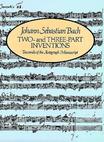Two and Three-Part Inventions 巴赫两三部创意曲
1968-6
Dover
Johann Sebastian Bach
62
无
Familiarity with composers' manuscripts is no longer the exclusive prerogative of the musicologist. There is a growing consciousness among musicians, students and music lovers of the need to consult the original manuscript to determine the authenticity of printed versions and to find valuable clues for interpretation. The Dover edition of Bach's Fifteen Inventions and Fifteen Symphonies (familiarly known as the Two and Three-Part Inventions) reproduces, in its original size, the1723 manuscript first written as an exercise book for the composer's son Wilhelm Friedemann. In Bach's own words, the Inventions help the pupil " . . . to achieve a singing manner of playing, and along with it to receive a strong foretaste of composi-tion." The Inventions were not published until 50 years after the composer's death,but have since come to occupy a special niche as the beginner's handbook and the professional keyboard player's reference for study and pleasure. The reproduction is from Bach's final fair copy and can be read for playing orappreciated as the unique manuscript text. "Nobody looking at these Dover reprintscan fail to respond to the incredibly beautiful scrpt of Bach . . . Suddenly the corn-poser is most spookily felt." Harold Schonberg, New York Times. Original Dover facsimile reproduction of autograph manuscript. Introduction by EricSimon. ix + 62pp. 81/8 x 11. Paperbound.

无
Two and Three-Part Inventions 巴赫两三部创意曲 PDF格式下载